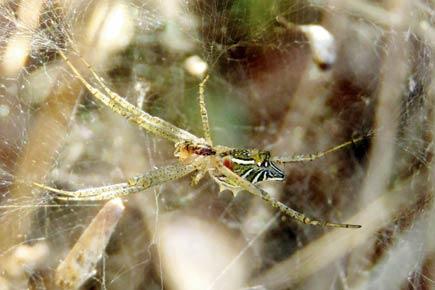There are hundreds of different creatures that share our homes and gardens. Most of us are either oblivious to their presence or abhor them

Cyrtophora cicatrosa at Nagla Block, Sanjay Gandhi National Park
 There are hundreds of different creatures that share our homes and gardens. Most of us are either oblivious to their presence or abhor them. Geckos, cockroaches, ants, flies and mosquitoes are categorically kept out via various mechanisms — nets, chemical sprays and electrical devices. Frequent repainting or cleaning during festivals also ensures that these creatures are kept at bay. Sadly, few realise the role these creatures play in the health and hygiene of our homes.
There are hundreds of different creatures that share our homes and gardens. Most of us are either oblivious to their presence or abhor them. Geckos, cockroaches, ants, flies and mosquitoes are categorically kept out via various mechanisms — nets, chemical sprays and electrical devices. Frequent repainting or cleaning during festivals also ensures that these creatures are kept at bay. Sadly, few realise the role these creatures play in the health and hygiene of our homes.
One of the most disliked and frequently exterminated creatures are spiders. They are hunters and predators of pests such as cockroaches, flies and mosquitoes and keep the household disease-free. Under such circumstances, one would think they would be popular with humans and welcome or worshipped in our homes. Sadly, the situation is quite the opposite.
ADVERTISEMENT

Cyrtophora cicatrosa at Nagla Block, Sanjay Gandhi National Park
Besides the irrational fear we had talked about earlier, called arachnophobia, the main reason spiders are hated in our household are their habit of making silken webs. Their delicate labour of love, which they weave to capture hovering pests and hang their egg cases, seems to somehow upset the image of neatness and tidy advertised by designer home magazines. On the one hand, the rising OCD of maintaining squeaky clean houses triggers repetitive clearing of webs, which is further aggravated by the lack of understanding of the ecological function that spiders play in urban dwellings.
I wouldn’t have been much upset if this rampant removal of spider webs was restricted to our livings quarters. However, the practise has extended to our gardens, yards, driveways and even to our urban ‘organic’ farms. If you take a little effort, even on cursory observation, you would realise that not all spiders make webs and some jump or forage around in search of prey. Among the web-forming spiders, most generally make linear or flat webs and are called flat orb-weavers. Sooner than later, you will encounter the amazing tent or dome-shaped webs, created by tent spiders from the Family Araneidae.
Tent spiders build three-dimensional webs which work differently from flat orb webs. The flat webs depend on sticky silk to entangle prey, which generally fly horizontally into the invisible trap. In contrast, the silk of 3D webs is not sticky and flying insects get knocked down by the sloping vertical silk lines onto a horizontal platform. The spider then runs out of its ingenious hiding place to capture and consume them. Out of the 38 species of tent spiders, each species has its characteristic hiding place. These 3D webs take several nights to build, are not rebuilt regularly and can last up to several weeks. As a result, some tent-webs can be very large and complex, with a delicate horizontal dome-shaped platform made up of fine, regular netting. The female generally hangs a single to multiple egg cases in the centre of the web to prevent predation by other spiders.
Observe closely or take close-up pictures and you will be shocked to see the prototype of the millennium dome right in front of your eyes. These tents are usually occupied by a single female spider and a few small males, but a few species are known to be colonial too. What is most unique about these tent webs is that a predator such as a gecko or wasp can almost never directly reach the hiding place of the spider.
One experiment suggests that while orb webs are not waterproof and water droplets remain on the web, the 3D tent webs are hence seen commonly near mangroves and other wet habitats.
These tent spiders are currently camped right in my window box-grill above my potted plants and trap any incoming disease carriers. I’m sure that just like we tolerate a wall hanging or dream-catcher, a little open-mindedness is expected towards these silken tent-makers.
Write in to Anand Pendharkar at sproutsenvttrust@gmail.com
 Subscribe today by clicking the link and stay updated with the latest news!" Click here!
Subscribe today by clicking the link and stay updated with the latest news!" Click here!







